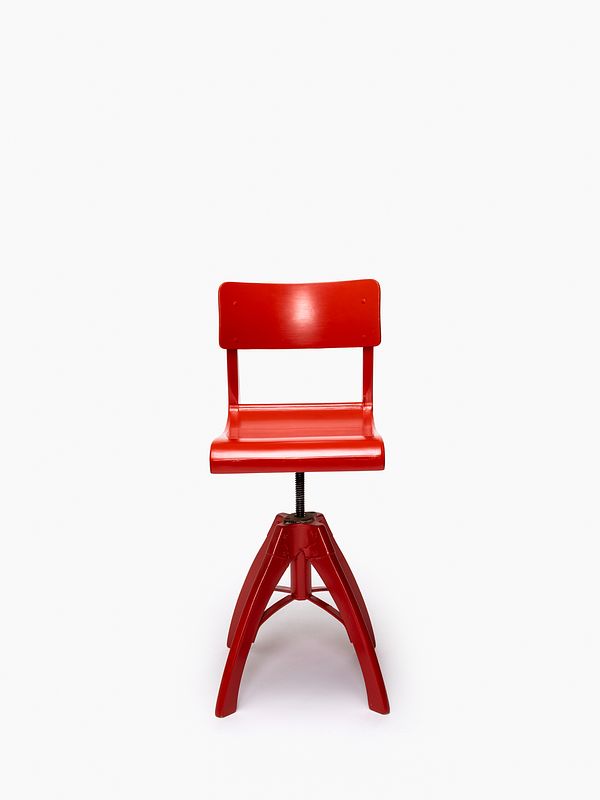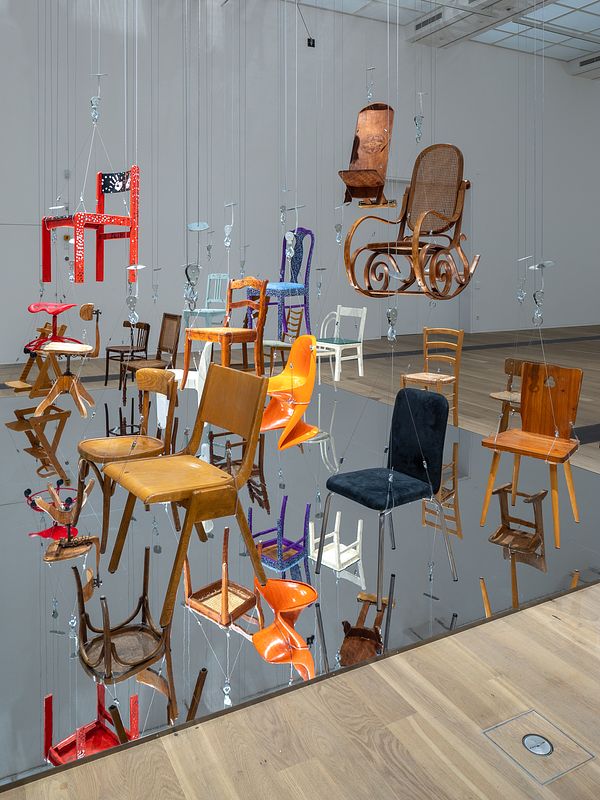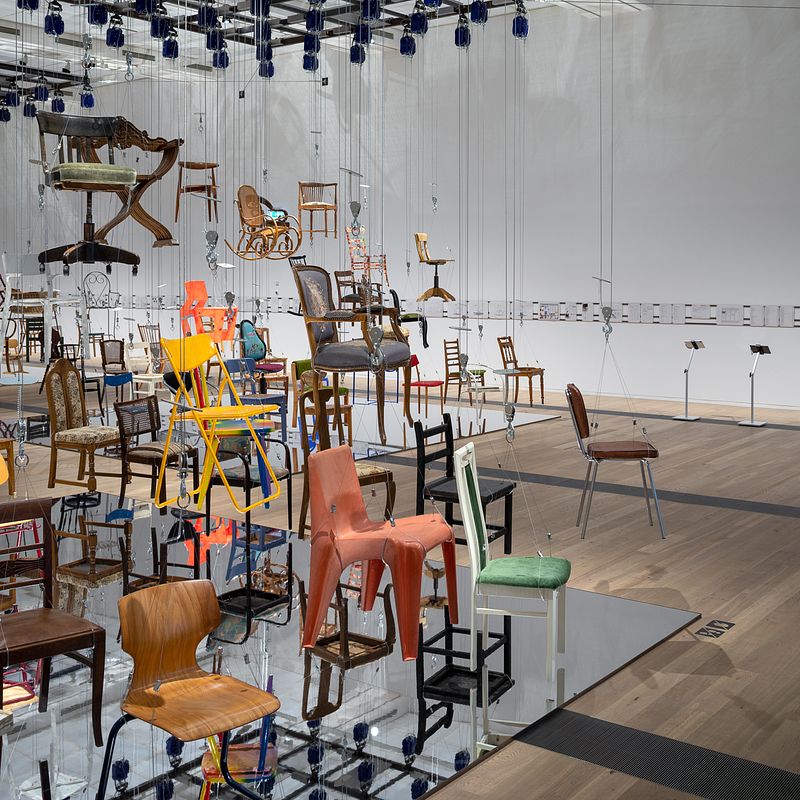17.01.2023
This essay first appeared in the magazine accompanying the exhibition THE FINAL BID. In the magazine you will find the illustrations of the chair models mentioned in the text. The magazine is available free of charge at the museum.
I asked 100 people: What is a chair? Seventy-six said a chair is a seat. Twelve said a chair is a status symbol. Five designers said a chair was a sketch in their drawer, and four people said a chair can also make good firewood in hard times. The remaining three people told me to mind my own business. You might have guessed it—I didn’t really ask 100 people.
I’m not Steve Harvey, after all, and this isn’t the American TV game show Family Feud. Nevertheless, I imagine the results of a survey of 100 people on the subject of chairs to be something along these lines. Each of us has our own thoughts on what exactly constitutes a chair. And your ideas probably coincide largely with mine. If we disagree, we can always consult the Cambridge Dictionary. It describes a chair as “a seat for one person that has a back, usually four legs, and sometimes two arms.” (1)
Wonderful! Finally a definition! But this, too, can rapidly reach its limits, as becomes clear, for example, when we look at the Panton Chair (1960) by the Danish designer Verner Panton. We would probably all agree that it is a chair, even if it doesn’t entirely meet the criteria of the Cambridge Dictionary. So what is a chair? Is it really just a piece of furniture to sit on, or does it serve other purposes?



What is a chair?
This essay first appeared in the magazine accompanying the exhibition THE FINAL BID. In the magazine you will find the illustrations of the chair models mentioned in the text. The magazine is available free of charge at the museum.
I asked 100 people: What is a chair? Seventy-six said a chair is a seat. Twelve said a chair is a status symbol. Five designers said a chair was a sketch in their drawer, and four people said a chair can also make good firewood in hard times. The remaining three people told me to mind my own business. You might have guessed it—I didn’t really ask 100 people.
I’m not Steve Harvey, after all, and this isn’t the American TV game show Family Feud. Nevertheless, I imagine the results of a survey of 100 people on the subject of chairs to be something along these lines. Each of us has our own thoughts on what exactly constitutes a chair. And your ideas probably coincide largely with mine. If we disagree, we can always consult the Cambridge Dictionary. It describes a chair as “a seat for one person that has a back, usually four legs, and sometimes two arms.” (1)
Wonderful! Finally a definition! But this, too, can rapidly reach its limits, as becomes clear, for example, when we look at the Panton Chair (1960) by the Danish designer Verner Panton. We would probably all agree that it is a chair, even if it doesn’t entirely meet the criteria of the Cambridge Dictionary. So what is a chair? Is it really just a piece of furniture to sit on, or does it serve other purposes?

Stuhl der Ausstellung THE FINAL BID
| © Draiflessen Collection, Foto: Henning Rogge
From form follows vanity to form follows intended place of use, and from form follows comfort all the way to form follows cruelty—for every idea there is a corresponding chair design.
Let’s start with form follows vanity. In 1645, when high-ranking delegations from the parties to the Thirty Years’ War met in Osnabrück and Münster to negotiate the end of this terrible conflict, it was first necessary to satisfy all the egos in attendance before the search for a European solution could begin. This required a newly developed diplomatic protocol. The principal envoys of the Electors were thus allowed to sit in armchairs, while the secondary envoys had to content themselves with chairs or benches with backrests. (2)
As this example from history makes clear: sitting is power! Over the centuries, the act of sitting—even on unusual furniture—has become more and more democratized. Today you can even have a lavish and comfortable throne designed and built for you, without needing to hold a God-given office to do so. It is a consideration that seems quite logical given the amount of time we spend seated. On average, Germans spend 7.5 hours a day sitting. (3)
Is the worry that we will give up our upright gait in the future, and develop into homo sedens, therefore justified? Things are probably not quite that bad yet. Nevertheless, sitting is a cause of concern for health-care systems around the world. Hence, we find ever more practical guides which promote physical exercises that we can do—surprise, surprise—while sitting down.
But let’s move on to the idea that form follows intended place of use. In the early twentieth century, the Austrian architect Otto Wagner designed not only the new headquarters of the Postsparkasse (Postal Savings Bank) in Vienna, but also all of its interior furnishings. He thereby made conscious use of materials to define hierarchical structures within the building. The standard chair designed by Wagner for the Postsparkasse was manufactured by Thonet as model no. 6516—a model, by the way, that can easily cost several hundred euros today, even in its plainest specification. By means of changes in the materials employed, Wagner created subtle but significant hierarchical gradations between the chairs. Thus, the chairs in the directors’ suites were made of dark-stained beech wood, with aluminum fixtures and sleeves on the arms and feet, and a seat upholstered in velour. By contrast, the basic version for the back offices, although it likewise featured the aluminum fixtures and sleeves, had an unpadded seat of perforated plywood. (4)
In this case, too, we can say that sitting illustrated power.
Let’s start with form follows vanity. In 1645, when high-ranking delegations from the parties to the Thirty Years’ War met in Osnabrück and Münster to negotiate the end of this terrible conflict, it was first necessary to satisfy all the egos in attendance before the search for a European solution could begin. This required a newly developed diplomatic protocol. The principal envoys of the Electors were thus allowed to sit in armchairs, while the secondary envoys had to content themselves with chairs or benches with backrests. (2)
As this example from history makes clear: sitting is power! Over the centuries, the act of sitting—even on unusual furniture—has become more and more democratized. Today you can even have a lavish and comfortable throne designed and built for you, without needing to hold a God-given office to do so. It is a consideration that seems quite logical given the amount of time we spend seated. On average, Germans spend 7.5 hours a day sitting. (3)
Is the worry that we will give up our upright gait in the future, and develop into homo sedens, therefore justified? Things are probably not quite that bad yet. Nevertheless, sitting is a cause of concern for health-care systems around the world. Hence, we find ever more practical guides which promote physical exercises that we can do—surprise, surprise—while sitting down.
But let’s move on to the idea that form follows intended place of use. In the early twentieth century, the Austrian architect Otto Wagner designed not only the new headquarters of the Postsparkasse (Postal Savings Bank) in Vienna, but also all of its interior furnishings. He thereby made conscious use of materials to define hierarchical structures within the building. The standard chair designed by Wagner for the Postsparkasse was manufactured by Thonet as model no. 6516—a model, by the way, that can easily cost several hundred euros today, even in its plainest specification. By means of changes in the materials employed, Wagner created subtle but significant hierarchical gradations between the chairs. Thus, the chairs in the directors’ suites were made of dark-stained beech wood, with aluminum fixtures and sleeves on the arms and feet, and a seat upholstered in velour. By contrast, the basic version for the back offices, although it likewise featured the aluminum fixtures and sleeves, had an unpadded seat of perforated plywood. (4)
In this case, too, we can say that sitting illustrated power.

Ausstellungsansicht Michael Pinsky, THE FINAL BID
| © Draiflessen Collection, Mettingen/Michael Pinsky, Foto/photo: Henning Rogge
In our own day, the maxim form follows comfort is increasingly important. While our forebears spent their days searching for food and water or laboriously tilling the soil, in today’s industrial societies more and more people have office jobs. In 2018, office workers made up 36.7 percent of the German labor force. (5)
All of these people need chairs. It is not surprising, therefore, that the office furniture market represents the most important area of chair design. (6)
In order to minimize the health issues that result from sitting for extended periods, the designers of office chairs endeavor to arrive at an ergonomically ideal solution that provides the spine with the best possible support. Such a chair should of course still be soft—and is therefore available in the desired padded upholstery.
We shall close with the notion that form follows cruelty. In 1888, Harold P. Brown, Frederick Peterson, and Alfred Southwick developed the electric chair. It was used for the first time in August 1890, and the three men won acclaim for their chair design. Indeed, this invention was considered a humane, civilized, and above all modern means of executing prisoners. So you can even die sitting. All of the chairs mentioned above, including this macabre example, make one thing clear: design processes are dependent on external factors. What at one period in the past may have been considered a sensible solution can appear exactly the opposite to us today. Design is thus always a mirror of the society associated with it, and of that society’s needs. Some would even go so far as to say that a chair’s design reflects the designer’s world view and their notions of an ideal society. (7)
So what is a chair? Why not have your own go at finding an answer to this question and take a look around our exhibition space. Perhaps your ideal chair is awaiting you there?
_______________________________________________________________
(1) See the definition of “chair” in the Cambridge Dictionary, https://dictionary.cambridge.org/dictionary/english/chair (all URLs accessed in August 2022).
(2) Niels F. May, Zwischen Fürstlicher Repräsentation und Adliger Statuspolitik: Das Kongresszeremoniell bei den westfälischen Friedensverhandlungen (Ostfildern: Thorbecke, 2016), p. 167.
(3) Egbert Maibach-Nagel, “Sitzen geblieben – DKV Gesundheitsreport 2015,” Deutsches Ärzteblatt 112, no. 5 (2015), p. 1.
(4) See the press pack issued by the former WAGNER:WERK museum upon its opening in 2005, pp. 15−16, https://web.archive.org/web/20070927040834/http://www.bawagpsk.
All of these people need chairs. It is not surprising, therefore, that the office furniture market represents the most important area of chair design. (6)
In order to minimize the health issues that result from sitting for extended periods, the designers of office chairs endeavor to arrive at an ergonomically ideal solution that provides the spine with the best possible support. Such a chair should of course still be soft—and is therefore available in the desired padded upholstery.
We shall close with the notion that form follows cruelty. In 1888, Harold P. Brown, Frederick Peterson, and Alfred Southwick developed the electric chair. It was used for the first time in August 1890, and the three men won acclaim for their chair design. Indeed, this invention was considered a humane, civilized, and above all modern means of executing prisoners. So you can even die sitting. All of the chairs mentioned above, including this macabre example, make one thing clear: design processes are dependent on external factors. What at one period in the past may have been considered a sensible solution can appear exactly the opposite to us today. Design is thus always a mirror of the society associated with it, and of that society’s needs. Some would even go so far as to say that a chair’s design reflects the designer’s world view and their notions of an ideal society. (7)
So what is a chair? Why not have your own go at finding an answer to this question and take a look around our exhibition space. Perhaps your ideal chair is awaiting you there?
_______________________________________________________________
(1) See the definition of “chair” in the Cambridge Dictionary, https://dictionary.cambridge.org/dictionary/english/chair (all URLs accessed in August 2022).
(2) Niels F. May, Zwischen Fürstlicher Repräsentation und Adliger Statuspolitik: Das Kongresszeremoniell bei den westfälischen Friedensverhandlungen (Ostfildern: Thorbecke, 2016), p. 167.
(3) Egbert Maibach-Nagel, “Sitzen geblieben – DKV Gesundheitsreport 2015,” Deutsches Ärzteblatt 112, no. 5 (2015), p. 1.
(4) See the press pack issued by the former WAGNER:WERK museum upon its opening in 2005, pp. 15−16, https://web.archive.org/web/20070927040834/http://www.bawagpsk.
com/__Contentpool/
UeberUns/Presse/Presse__Aktuell/Pressemappe__WagnerWerk__pdf,property=Data.pdf.
(5) Andrea Hammermann and Michael Voigtländer, “IW-Trends 3/2020: Bürobeschäftigte in Deutschland,” Vierteljahresschrift zur empirischen Wirtschaftsforschung, vol. 47 (Cologne: Institut der deutschen Wirtschaft, 2020), p. 66.
(6) Charlotte Fiell and Peter Fiell, 1000 Chairs (Cologne, 2010), p. 9.
(7) Ibid.
UeberUns/Presse/Presse__Aktuell/Pressemappe__WagnerWerk__pdf,property=Data.pdf.
(5) Andrea Hammermann and Michael Voigtländer, “IW-Trends 3/2020: Bürobeschäftigte in Deutschland,” Vierteljahresschrift zur empirischen Wirtschaftsforschung, vol. 47 (Cologne: Institut der deutschen Wirtschaft, 2020), p. 66.
(6) Charlotte Fiell and Peter Fiell, 1000 Chairs (Cologne, 2010), p. 9.
(7) Ibid.

Ausstellungsansicht Michael Pinsky, THE FINAL BID
| © Draiflessen Collection, Mettingen/Michael Pinsky, Foto/photo: Henning Rogge
This essay was written by Stefan Spitzer, trainee at the Draiflessen Collection in the area of museum education and outreach.
It appeared in the magazine accompanying the exhibition THE FINAL BID.
It appeared in the magazine accompanying the exhibition THE FINAL BID.